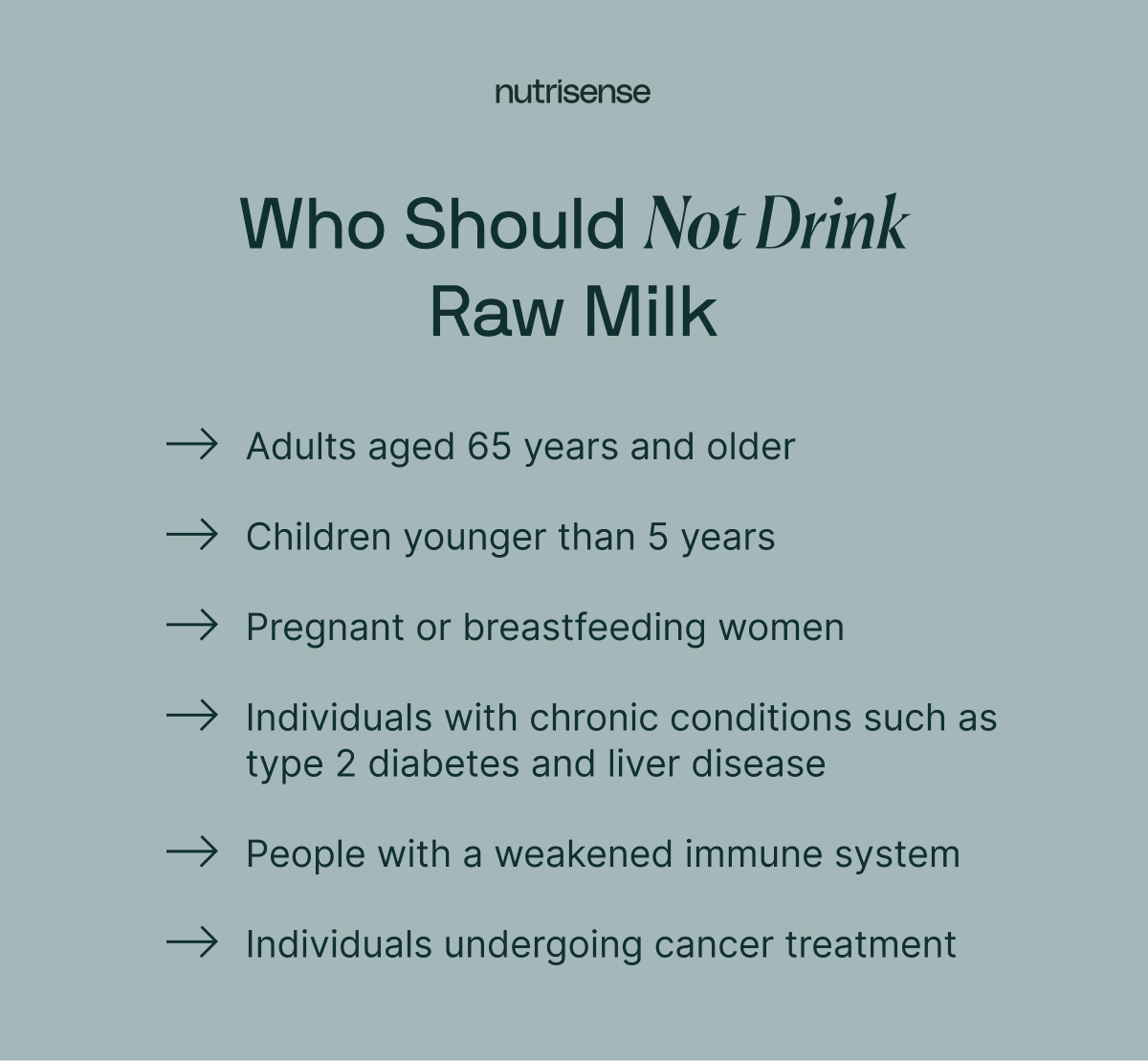Is Raw Milk Good For You? Weighing the Pros and Cons

Key Takeways
These days, many people are adding more natural, unprocessed foods to their diet, and for good reason. Unprocessed foods, like fresh fruits and vegetables, offer many health benefits, like supporting stable glucose levels, lower inflammation, and enhanced mental health.
Raw milk is considered a natural, unprocessed food. However, while some view it as a health food, others view it as a potential threat to public health.
So, what’s all the controversy about, and should you drink raw milk? Read on to learn more about the pros and cons of raw milk.
What is Raw Milk?

Raw milk is simply milk that hasn't been heated up (pasteurized) or altered in any way. Most milk that you buy in the supermarket is pasteurized, which is a process that involves heating the milk to kill potentially harmful bacteria.
Most commercially-sold raw milk comes from cows, but it can also come from goats, sheep, buffalo, or camels (yes, camels!).
Raw milk can be consumed on its own or used to make traditional dairy products like butter, cheese, yogurt, and ice cream.
Raw Milk vs. Pasteurized Milk
Store-bought milk is called "pasteurized milk" because it’s heated in a process called pasteurization. The pasteurization process for milk became popular in the 1900s when it was discovered that cow's milk could spread diseases like tuberculosis and diphtheria.
Pasteurizing involves exposing milk to a high temperature to eliminate harmful bacteria and viruses, like E. coli and Listeria. The high heat also kills other pathogens and enzymes that can spoil the milk, extending its shelf life. Immediately after it’s pasteurized, milk is rapidly cooled down to lock in freshness.
On the other hand, raw milk, or "unpasteurized milk," doesn’t go through this heating process. Instead, it’s directly cooled to 40 degrees Fahrenheit to keep it fresh.
This cooling process is standard practice for both types of milk. The key difference between raw milk and pasteurized milk is the heating process.
Potential Nutritional Benefits of Raw Milk

Raw milk advocates often say that heating milk to high temperatures can remove critical nutrients. They believe raw milk, which isn't heated, keeps all its nutrients, making it healthier.
They also claim that raw milk is better for the gut, can help with allergies, and is safe for people with lactose intolerance. Let's explore these health claims and what the research says about any potential health benefits of raw milk.
Better Gut Health
A common claim is that raw milk is good for gut health. A study in 2020 seemed to support this idea, showing that people who drank raw milk had more "Lactobacillus" bacteria, which is considered a good bacteria for the gut.
But, this study has major limitations. It didn't account for other things that could affect gut health, like stress, sleep, and artificial sweeteners. This oversight makes the results of this study inconclusive.
Raw milk is also believed to contain more "good" probiotic bacteria strains, like Bifidobacteria or Lactobacillus acidophilus. However, studies show that both raw and pasteurized milk contain low levels of these probiotics but are high in lactic acid bacteria.
Research also shows that the beneficial bacteria in milk can survive pasteurization. For these reasons, raw milk may not be better than pasteurized milk for gut health.
Amino Acid and Protein Content
Milk is known as a high-quality or complete protein because it contains all nine of the essential amino acids that you must get from food. Casein and whey protein are the major proteins found in milk. Casein makes up about 80 percent of the total protein of milk, while whey protein makes up about 20 percent.
Some claim that pasteurizing milk reduces the amino acid and protein content, making raw milk a better option. However, a 2015 study revealed that pasteurized milk had protein and lactose content similar to raw milk.
Studies do show that pasteurizing can alter the shape of whey proteins. Still, this alteration is insignificant and doesn't affect how the body uses the protein and amino acids.
Some pasteurizing techniques may actually be more beneficial. For example, a 2008 study found that milk that underwent ultra-high-temperature (UHT) pasteurization positively impacted how the body uses amino acids.
More Fatty Acid Content
Milk contains various types of fatty acids, from long-chain to short-chain fatty acids. Another popular claim when it comes to raw milk is that raw milk contains more healthy fats than pasteurized milk.
A 2015 study tested this theory by comparing raw milk's fatty acid composition to pasteurized milk. While there were slight variations in short-chain fatty acids, the overall fat profiles of raw and pasteurized milk in the study were similar.
More Vitamins and Minerals
Another proposed benefit of raw milk is that it contains more vitamins and minerals, so a 2011 meta-analysis set out to review this claim.The researchers found that pasteurizing milk reduces the levels of specific vitamins such as:
- Folate
- Vitamin C
- Vitamin B12
- Vitamin E
Interestingly, pasteurization increases the levels of vitamin A.
Luckily, milk isn’t a primary dietary source of folate, vitamin C, B12, or E, so decreasing these vitamins in pasteurized milk doesn’t raise health concerns. It's also worth noting that most pasteurized milk sold in the U.S. is fortified with vitamin D and vitamin A, adding to milk's nutrient profile.
Protects Against Allergies
Some claim that drinking raw milk is linked to fewer allergies. Studies have found that different factors, like genetics, diet, and lifestyle, can impact the chances of developing allergies.
One interesting observation is that kids who grow up on farms and drink raw milk tend to have fewer allergies. But it's probably not just one thing like raw milk that makes the difference—it's likely a mix of many factors.
Exposure to different microbes and being outside more may help bolster the immune system and lower the risk of allergies.
May Be Better for Lactose Intolerance
Lactose is a type of sugar present in milk. Your body naturally produces an enzyme called lactase to break it down during digestion.
People with lactose intolerance don't produce enough lactase, leading to discomfort like gas and diarrhea when they consume dairy.
Some believe raw milk might be easier to digest for people with lactose intolerance. Interestingly, a 2014 survey reported that about 30 percent of participants who drank raw milk products said they didn't experience any stomach issues, unlike when they consumed regular milk.
But when scientists did a study on 16 people with lactose intolerance, they found that raw milk didn't make a difference. So, even though some people think raw milk is easier to digest, that might not be true for everyone. People with lactose intolerance may be better off with a non-dairy alternative, like almond milk.
Does Raw Milk Spike Blood Sugar?

Drinking raw milk might cause your blood sugar to rise. This happens because all milk, whether raw or pasteurized, has about 11 grams of carbohydrates in each cup. The body converts these carbohydrates into glucose, which impacts your blood sugar.
But it's not all about the carbs—milk also has fats and proteins that help smooth out your blood sugar, making the changes less drastic.
Other factors can also influence your blood sugar response. Physical activity levels and individual health conditions all affect how your body responds.
Take a look at this experiment our partner Jason conducted to see how raw milk might impact his blood sugar:
What Risks are Associated with Drinking Raw Milk?
The most significant risk of drinking raw milk is the potential for foodborne illness outbreaks. Raw milk may contain pathogens that can make you sick, like E. coli, Listeria, Brucella, and Salmonella.
Listeria is especially dangerous to pregnant women as it has been linked to miscarriage, stillbirth, and preterm labor. Given these health concerns, numerous countries, like Australia, Canada, and Scotland, have banned the sale of raw milk.
In the United States, the sale of raw milk is prohibited in 20 states. Additionally, federal regulations from the FDA and Centers for Disease Control and Prevention caution against the human consumption of raw milk due to safety concerns.
Is it Safe to Drink Raw Milk?
It depends—drinking raw milk carries certain risks that can’t be ignored.
Unlike pasteurized milk, which has been heated to kill harmful bacteria, raw milk can contain dangerous pathogens like E. coli, Campylobacter, Salmonella, and Listeria. These bacteria can cause severe illness and sometimes even life-threatening conditions.
Raw milk advocates argue that raw milk from healthy, grass-fed animals managed under strict hygienic conditions has minimal health risks. However, according to Foodborne Disease Outbreak Surveillance System database, there were 675 illnesses and 98 hospitalizations linked to raw milk outbreaks between 2013 and 2018.
If you're considering trying raw milk or raw dairy products, it's essential to pick a trusted farm that follows strict cleanliness rules to reduce risks. Always talk to a doctor or a nutritionist first to see if raw milk is okay for you.
Who Should Not Drink Raw Milk?

Certain groups of people should avoid consuming raw milk because of the risk of foodborne illness. This includes:
- Adults aged 65 years and older
- Children younger than five years old
- Pregnant or breastfeeding women
- Individuals with chronic conditions such as type 2 diabetes and liver disease
- People with a weakened immune system
- Individuals undergoing cancer treatment
The Bottom Line
Even though raw milk is becoming more popular, there is no strong evidence at this time to support claims that it is healthier or has greater nutritional value than pasteurized milk. Before you drink raw milk, consider the pros and cons and talk to your healthcare provider or nutritionist to see if it's right for you.
Find the right Nutrisense programto turn insight into progress.
Go Beyond Glucose Data with Nutrisense
Your glucose can significantly impact how your body feels and functions. That’s why stable levels are an important factor in supporting overall wellbeing. But viewing glucose isn't enough. Nutrisense, you’ll be able to learn how to use your body's data to make informed lifestyle choices that support healthy living.
One-to-one coaching
Sign up to access insurance-covered video calls to work with a glucose expert: a personal registered dietitian or certified nutritionist who will help tailor your lifestyle and diet to your goals.
Monitor and measure what matters
With the Nutrisense CGM Program, you can monitor your glucose with health tech like glucose biosensors and continuous glucose monitor (CGM)s, and analyze the trends over time with the Nutrisense App. This will help you make the most informed choices about the foods you consume and their impact on your health.
Find your best fit
Ready to take the first step? Start with our quiz to find the right Nutrisense program to help you take control.

Jordyn has a bachelor’s degree in biology, a graduate degree in Human Nutrition and completed a dietetic internship at the Memphis VA. She's a dietitian at Nutrisense, and has experience working as a clinical dietitian at a VA medical center specializing in oncology and at the Mayo Clinic, working with a wide range of patients ranging from neonates in the NICU to adult ICU.




